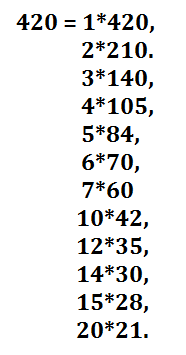Consecutive integers can be represented as follows:
\(m, m+1, m+2, ..., m+k\)
The above is a sequence of k+1 consecutive integers, and the sum of these can be calculated by noting that the sum has two parts: one part consists of adding m to itself k+1 times, and the second part is calculating the sum of 1, 2, 3, ..., k.

\(1 +2 + 3+...+k\)
the first sum is simply (k+1)m;
the second one has a well-known formula, \(\frac{k(k+1)}{2}\).
Adding these together we get \(m(k+1)+\frac{k(k+1)}{2}\).
In order to use the formula without having to solve complicated equations we will write the sum above as
\(\frac{(2m+k)(k+1)}{2}\).
We first assume that m is a positive integer, and try to solve the equation
\(210=\frac{(2m+k)(k+1)}{2},\)
which is the same as \(420=(2m+k)(k+1)\).
Now this equation has two variables and it is not easily solved, so we will resort to a trick; We write all the paired factors of 420 and by trial and error find the correct pair matching the factors on the right side of the equation.

I will leave out my trials and mostly errors and tell you that the last pair of factors would give you the longest chain of consecutive integers for positive m. If we let k+1 = 20 , and 2m + k = 21, we end up with the chain
1 + 2 + 3 +...+ 20 = \(\frac{20(21)}{2}=210\).
For m a negative integer there were many more trials and mostly errors and again I will spare you and give you the answer I should have known right away but unfortunately did not: Let
k+1 = 420, and
2m+k = 1.
Highly surprising even though it seems, it would give you k= 419, and m = - 209, and the chain
\( -209, -208, -207, ..., 1, 0, 1, 2, ..., 209\)
has the correct length and the correct sum
\(\frac{(2(-209)+419)(419+1)}{2}=\frac{1(420)}{2}=210\).